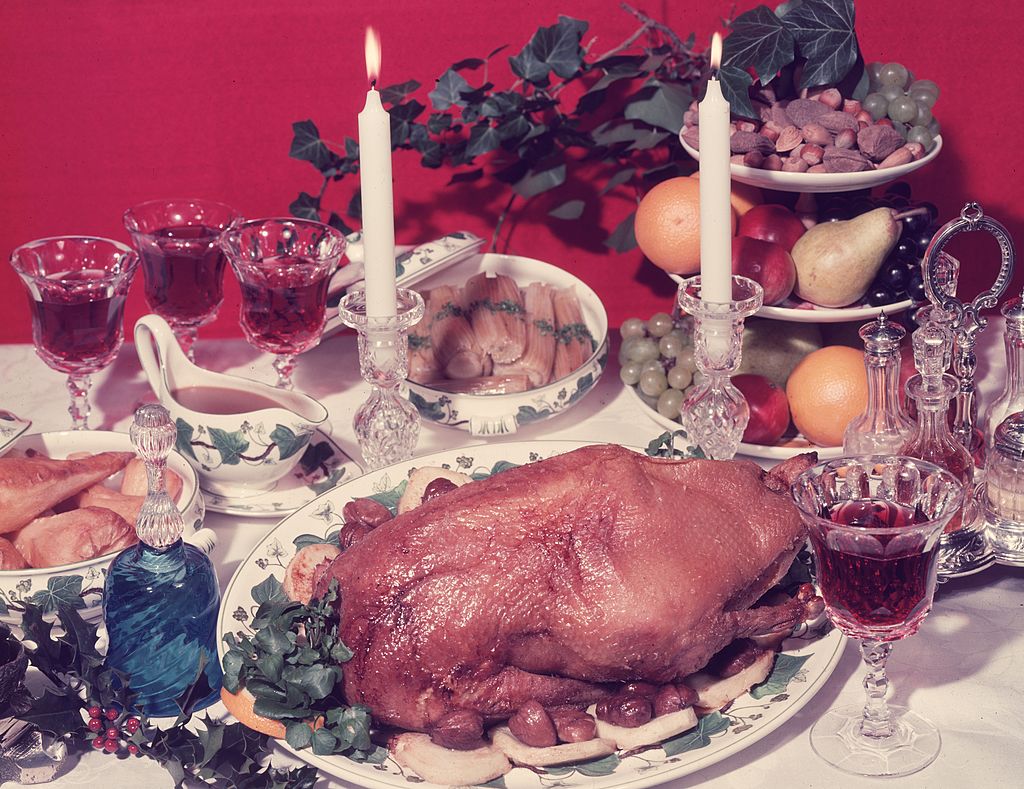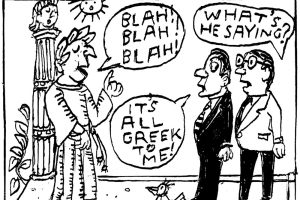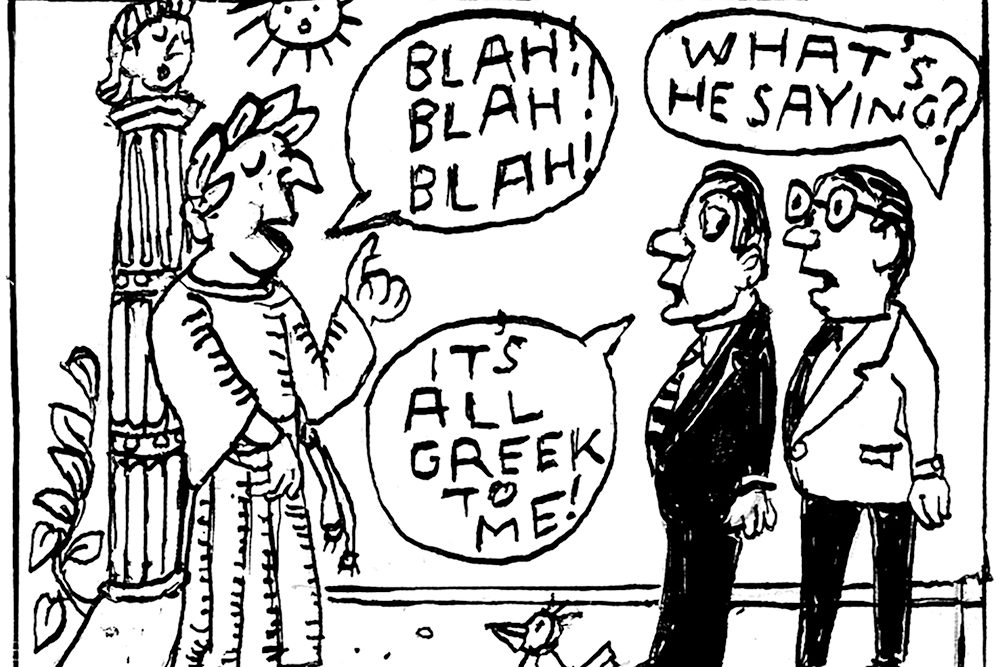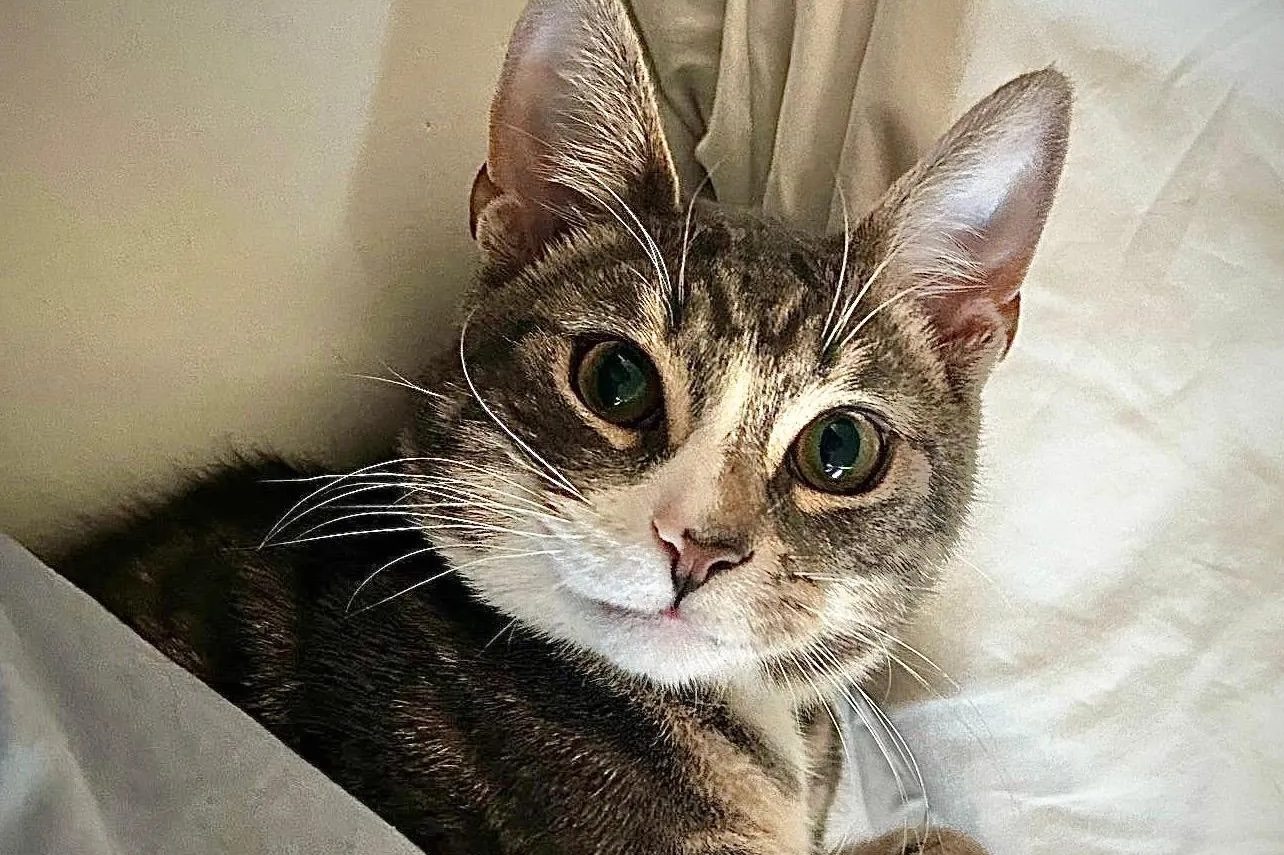I am first reunited with the homely and comfortable: I settle myself in the familiar corner, under a blue knitted wool blanket, with a tag that reads Handmade With Love by Kathleen E—. To my right is one of my father’s many furniture creations, stumps of trees sanded down and finished, or scrapwood configured into striking geometric edifices. In the kitchen is the long work and dining table built by one of his buddies. Across from me is the shronk, a word in the family idiolect whose probable Pennsylvania Dutch origins have now been lost to time, which refers to the massive wooden hutch that my great grandmother had made from the paneling of her farmhouse.
Later come the festive objects — not so much the lights and decorations themselves, as delightful as they are, but the housewares consecrated to the most fulsome degree of hospitality. As children, it was our job to polish my great grandmother’s silver, hauled out from the dark cupboard in preparation for Christmas. We dipped rags into the pink chemical foam, buffing and scrubbing, watching the domestic miracle that transmuted dull tarnish into soft bright gleam. The silver teapot caught the light in a different way than the gold leaf on the bright china at Thanksgiving, and in a different way again from the sparkle of the crystal wine glasses. When I remember those repeated Thanksgivings and Christmases, I remember how the light, caught and held, gleaming and sparkling and shining, made the room look enchanted. The thumb-sized crystal cordial glasses for Drambuie or Cointreau that went around after pie cemented my suspicions: I was in fairyland. Now, decades later, my great aunt takes down the rosewood tea box, at once so solid and delicate, its treasures so neatly ordered, and I am there again, nine years old and wide-eyed.
I was not without some cause to think this way. In fairytales and ballads, a sure sign that you have crossed a border beyond the ordinary human world is the opulence of the objects. Bridles are silver and gold, linen shirts are spun thin as spider’s silk, combs are made of pearl. It may seem a strangely gaudy set of paraphernalia for realms supposed to be more ethereal or spiritual than mundane humane life. But then, the people who were telling and singing and listening were intimately acquainted with the cost, scarcity, and fragility of beautiful things. Their abundance did not represent a showy parade for the neighbors, but a degree of freedom and power unimaginable for toiling humans.
Every year I reacquaint myself with the linen and lace, silver and china, glass and crystal, laid out on the long tables in careful arrangements, ornate without being crowded, never anything more or less than needed. The first hour I spend in an orgy of touching things.
These objects signal and structure the holiday season for me, from Thanksgiving to Christmas through New Years, bringing a vivid, necessary, physical festivity and abundance. Like the silver bridles of fairyland, they make you viscerally aware that you are in a special place and time. But it is precisely this class of material goods that can be a hard sell nowadays. Handmade creations have the distinction of craft, and a personal connection to the maker. But the mass-produced yet fragile and expensive apparatus of formal entertaining is difficult to contemplate when storage is at a premium and you move every few years. It is vulnerable to various accusations: lace-curtain, fussy, petit bourgeois, and above all, stuffy.
This Thanksgiving, with thirty odd people expected, an unnamed niece was so unwise as to suggest that my great aunt eschew flatware in favor of favor plates. The tiny, kindly woman bared her fangs like a tiger, and the matter was hastily dropped. But Aunt Kathleen is in the minority. Wedding registries are more likely to contain top-of-the-line blenders than Waterford crystal.
Alison Roman, whose beloved recipes has become enmeshed in an entire thirty-something millennial aesthetic, titled her second cookbook “Nothing Fancy.” Dinner parties and pitchers of martinis do not require, it seems to reassure readers, any loss of down to earth casualness. Conscious minimalism is a thought-leader staple, its advocates expounding the virtues of clean, blank, space stripped down to the functional essentials — space that leaves room for what’s really important.
Perhaps the most conspicuous and emblematic heralds of thoughtful minimalism can be found under the Instagram hashtag #vanlife. The #vanlife crew travels the world with Macgyvered RVs and a bare bones lifestyle. Their tiny interiors hold only the most necessary home goods. They walk the walk that many minimalism influencers talk: experiences matter more than things.
“Experiences matter more than things” is more than the credo of influencers. It is a sentiment so widely shared that it can almost be taken for granted. To demur is to range yourself on the side of a grasping materialism. It is to announce yourself as the kind of person who might reject the thoughtful gift of a book because what you really wanted was a Tiffany’s bracelet, or who cannot stop bragging about the size of their new television; the kind of person who, with sufficient wealth, might gild their toilet seats.
But unlike “people matter more than things” the cousin it sometimes impersonates, “experiences matter more than things” does not transcend consumption, but chooses between consumptions. The Tiffany bracelet becomes the trip to Iceland; the good china becomes the craft cocktail bar.
The rub is that experience-based consumption is, like human experience in general, ephemeral. The role of consumption in visibly defining your place in the world does not evaporate just because you are consuming experiences. You need some way to make them permanently accessible — the trip to Iceland must become the trip to Iceland as documented on Instagram.
Humans are by nature always trying to turn experiences into things, to cast liquid silver into a permanent mold, to bring back a pearly comb from fairyland. One virtue of the linen and china is that they accomplish this in a way the flat Instagram post never can. They externalize and embody the magic of the experiences to which they correspond, bringing a mood and a memory to life by their mere presence. They do not promise an illusory permanence for any given moment of holiday cheer, but by their solidity and stability, they extend its life by repetition and renewal, as coppiced trees cut back and regrown can live hundreds of years.
And there is a generative element to the way that the magic of an experience comes to reside in a physical object. My aunt once asked me what I’d like for a gift. The cobalt blue glass water goblets she used at her table, I answered. The color in them had always seemed inexpressibly rich to me, a dark, glassy sea in the palm of my hand. She tracked them down on the internet and bought them for me. They are not uncommon or hard to find, not especially expensive, not distinguished by the kind of design elements that create cult followings. But they sit on my table now, and my dinner parties participate in the graceful, gleaming, candle-lit enchantment of my aunt’s — a new shoot, a new node.
The beautiful objects of hospitality create a theater for the type of experiences that are by nature capacious, shared among young and old and in between, connecting one to another. This capaciousness extends beyond young and old, all the way to the living and the dead. There are people whose long-finished lives are only dimly known to me, but whom I meet and cherish every year in the physical memorabilia they handed down: great grandmother’s silver, pottery made by my grandfather’s sister. Even ridiculous kitsch can gain a new dignity this way. Each Thanksgiving I greet a grinning plastic monkey that was my great Aunt Gertrude’s. I would miss him greatly if he were ever gone.
Not even silver lasts forever, but handing it down is a promise that we will make the threads of connection, to the past and to the growing contingent who share it, last as long as we can. And as the years of experiences and memories solidify and settle into their physical vessels, even the purchased department store flatware acquires a new importance. One of the cruelest aspects of human ephemerality is that all the settled traditions, all the familiar experiences that feel so permanent and fundamental in childhood, are in fact the product of a contingent constellation of people whom death is always mowing down. As the years go by, every physical element of these vanishing times, every object that can establish continuity with them and the people who left them behind, grows in significance.
It would be a shame to give up on the festive, beautiful, perhaps unnecessary objects that structure and bewitch our lives, despite all the real difficulties of apartment living and similar social factors. But perhaps we are in less danger than we seem. The van of #vanlife is in its own way a notable and curious object. And the other day, looking at photographs of an old romany wagon, I was struck by the richness of the fabrics, the lovingly displayed plates and pictures and ornaments, the ornate and colorfully painted carving; as if the hardships of the road and confinement of the space only made the physical treasures of daily life more precious. Perhaps, after all, the urge to escape the burden of material possessions will only lead us smack into a deeper romance with them.

























